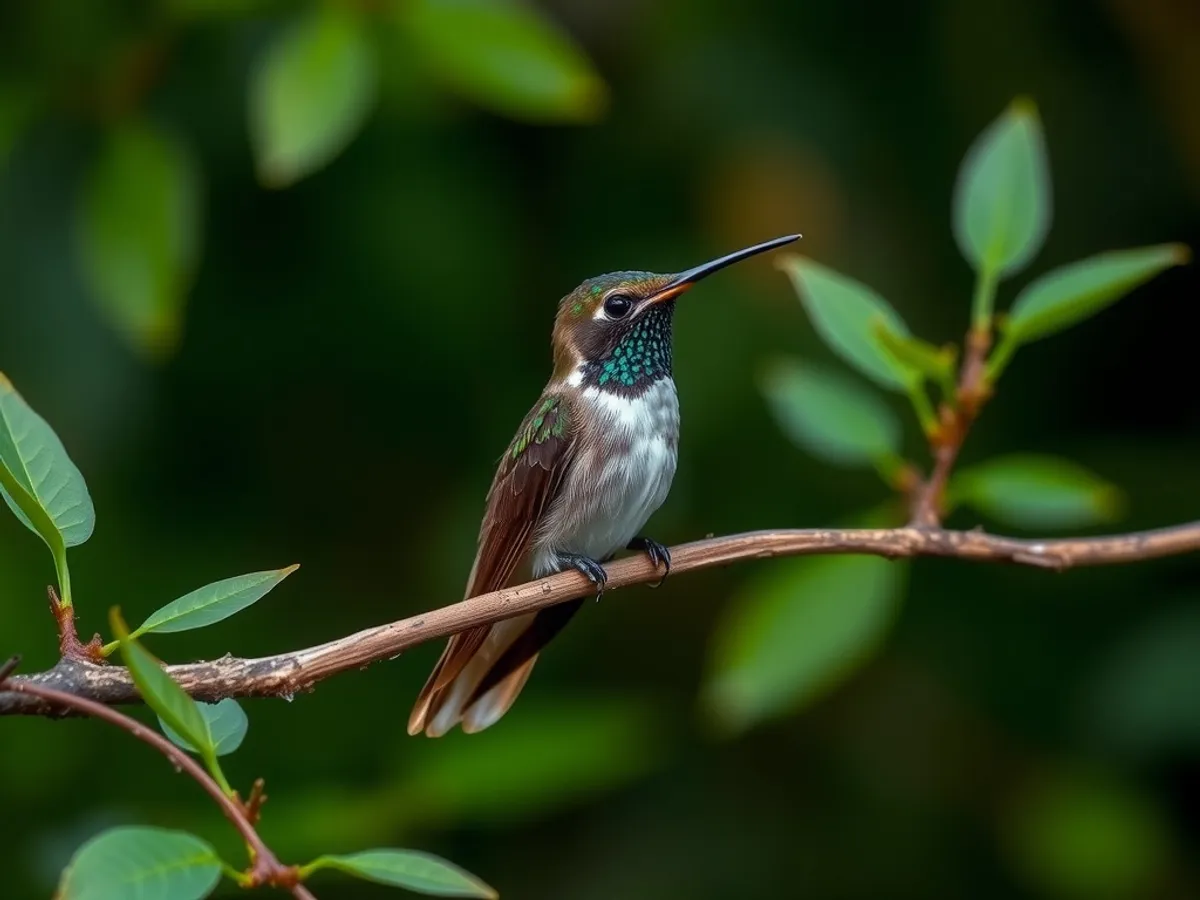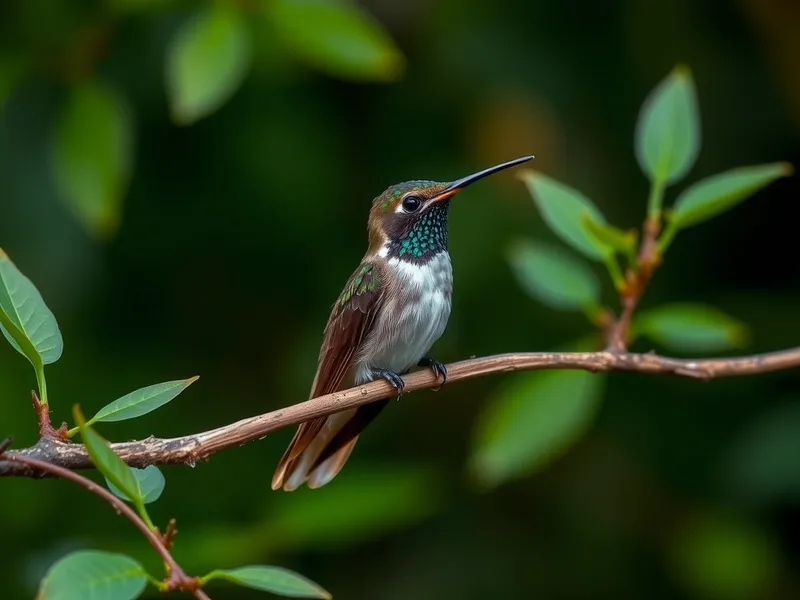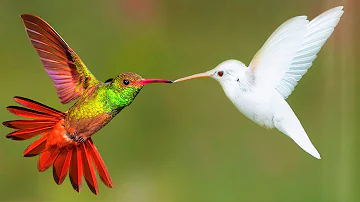
Bee Hummingbird
Mellisuga helenae

Meet the Bee Hummingbird
The Bee Hummingbird is the smallest bird in the world, measuring just about 5 to 6 centimeters in length and weighing less than 2 grams. Native to Cuba and the Isla de la Juventud, this tiny bird is renowned for its iridescent, vibrant plumage and rapid wingbeats, which can reach up to 80 flaps per second. Bee Hummingbirds feed primarily on nectar, playing a vital role in pollination, and can visit over 1,500 flowers in a single day. Despite their minute size, they are fiercely territorial and display remarkable agility in flight.
Classification
Bird
Habitat
Dense forests, forest edges, and gardens in Cuba and Isla de la Juventud
Diet
Nectarivore
Lifespan
5-7 years
Conservation
Near Threatened
Weight
1.6–2.0 grams
📖Fascinating Facts
Master Pollinator
Bee Hummingbirds pollinate many native Cuban flowers, contributing significantly to the local ecosystem.
Tiny Titan
Despite its size, the Bee Hummingbird is highly territorial and will aggressively defend its feeding grounds from much larger birds.
Dazzling Feathers
Males display striking iridescent blue and red feathers during the breeding season to attract females.
📋Detailed Description
The Bee Hummingbird (Mellisuga helenae) is the smallest extant bird species, with adult males averaging 5.5 cm in length and weighing approximately 1.6–1.9 grams, while females are slightly larger at about 6.1 cm and up to 2.6 grams. Its plumage is highly iridescent; males display a brilliant metallic red to pinkish head and throat, with bluish upperparts and white underparts, while females are generally bluish-green above and pale gray below. The bill is straight, slender, and slightly decurved, perfectly adapted for probing deep into flowers. The wings are short but extremely powerful, enabling hovering flight and rapid maneuverability; their wingbeat frequency can reach up to 80 times per second during normal flight and even higher during courtship displays. The Bee Hummingbird has a high metabolic rate, with a heart rate that can exceed 1,200 beats per minute and a breathing rate of up to 250 breaths per minute. It possesses specialized tongue morphology with fringed, forked tips that facilitate efficient nectar extraction via capillary action. This species is generally solitary outside of the breeding season, fiercely defending feeding territories from conspecifics and other nectarivores. Its vocalizations are high-pitched and rapid, used primarily for territory defense and courtship. The Bee Hummingbird is endemic to Cuba and the Isla de la Juventud, inhabiting dense forests, forest edges, coastal thickets, and occasionally cultivated gardens.
💡 Did you know?
A Bee Hummingbird’s egg is about the size of a coffee bean and is one of the smallest of any bird species.
🔬Research & Sources
Wikipedia Summary
The bee hummingbird, zunzuncito or Helena hummingbird is a species of hummingbird, native to the island of Cuba in the Caribbean. It is the smallest known bird. The bee hummingbird feeds on nectar of flowers and bugs found in Cuba.
Last Modified: 5/24/2025
🎭Behavior & Social Structure
Bee Hummingbirds are diurnal and highly active, spending the majority of daylight hours foraging for nectar and small arthropods. They exhibit traplining behavior, following a regular route to visit specific flowering plants. Males are territorial, aggressively chasing away intruders from their preferred feeding sites using aerial displays and vocalizations. Feeding involves hovering in front of flowers and inserting the bill to lap up nectar, while also catching small insects and spiders mid-air or gleaning them from foliage to supplement their protein intake. They rest intermittently on exposed branches between feeding bouts. During the breeding season, males perform elaborate display flights, including rapid ascents and dives, to attract females. Social interactions are mostly limited to brief encounters during courtship or territorial disputes.
👶Reproduction & Life Cycle
The breeding season for Bee Hummingbirds typically occurs from March to June, coinciding with peak flowering periods. Males establish and defend small display territories where they perform courtship flights and vocalizations to attract females. After mating, females are solely responsible for nest construction, incubation, and chick rearing. The nest is a tiny cup-shaped structure made from plant down, spider silk, and lichen, usually placed on a slender branch or fork 1–3 meters above ground. Females lay two white eggs, each measuring about 1 cm in length. The incubation period lasts 21–22 days, and the chicks fledge approximately 18–24 days after hatching. Parental care is provided exclusively by the female, who feeds the chicks with regurgitated nectar and insects.
🛡️Adaptations & Survival
Bee Hummingbirds exhibit several remarkable adaptations for their miniature size and nectarivorous lifestyle. Their extremely high metabolic rate is supported by a proportionally large heart and efficient respiratory system. Specialized flight muscles and a unique ball-and-socket shoulder joint allow for rapid wingbeats and precise hovering. The tongue is highly extensible and equipped with lamellae for rapid nectar uptake. Their iridescent plumage aids in sexual selection and camouflage among flowers. Behavioral adaptations include traplining and territoriality, optimizing energy expenditure and resource defense. They can enter torpor at night to conserve energy, dramatically reducing metabolic rate and body temperature.
🎨Cultural Significance
The Bee Hummingbird holds a special place in Cuban culture, where it is known as 'zunzuncito.' It is celebrated in local folklore and poetry as a symbol of beauty, agility, and resilience. The bird's diminutive size and dazzling colors have inspired numerous works of art and are often associated with love and good fortune. While not traditionally hunted or used in crafts, its presence in gardens is considered auspicious, and it is a flagship species for conservation awareness in Cuba.
🔬Recent Research & Discoveries
Recent research on Mellisuga helenae has focused on its metabolic physiology, revealing insights into the limits of vertebrate miniaturization and energy expenditure. Studies using high-speed videography have documented the biomechanics of its hovering and courtship displays. Genetic analyses have clarified its phylogenetic position within Trochilidae and highlighted its evolutionary divergence from other Mellisuga species. Ongoing field studies are monitoring population trends and the effects of habitat alteration, while conservation programs are promoting the restoration of native flowering plants to support hummingbird populations.
🎥Wildlife Videos

David Attenborough Presents: Hummingbirds - Jewelled Messengers | Free Documentary Nature
David Attenborough Presents: Hummingbirds - Jewelled Messengers | Nature Documentary Watch 'Birds of Passage - A Secret ...
Free Documentary - Nature

Meet The Smallest Bird On Earth
The very smallest bird on Earth is the Bee Hummingbird, which can be found in the Zapata. Please LIKE and SUBSCRIBE if you ...
Nature on PBS

Hummingbirds of Hollywood | PBS Nature Documentary
Watch on your local PBS station, the PBS video app, online, and here on YouTube through May 6, 2029. This program is made ...
Nature on PBS

Hummingbird Facts And More About The Smallest Bird Species
Native to the Americas, the average hummingbird weighs 5 grams - or just as heavy as a single sheet of paper. Despite their size ...
Facts Net

Two Hummingbirds Battle for Nectar | Untamed Andes
About National Geographic Wild: National Geographic Wild is a place for all things animals and for animal-lovers alike. Take a ...
Nat Geo Animals

10 Most Spectacular Hummingbirds in the World
4 Ever Green is the #1 place for all your heart warming stories about amazing people, beautiful animals and cute things that will ...
4 Ever Green
🌍Habitat Information
The Bee Hummingbird typically inhabits Dense forests, forest edges, and gardens in Cuba and Isla de la Juventud environments. Bee Hummingbirds have adapted to their environments with specialized features and behaviors.
Primary Habitat:
Dense forests, forest edges, and gardens in Cuba and Isla de la Juventud
More detailed habitat information will be available soon.
🛡️Conservation Status
The Bee Hummingbird is currently classified as Near Threatened. Conservation efforts are crucial for preserving this species for future generations.
Common Threats:
- 🏠Habitat loss and fragmentation
- 🌡️Climate change impacts
- 🎯Hunting and poaching
- 🏭Human-wildlife conflict
⚠️Threats & Conservation Challenges
The primary threats to Bee Hummingbirds are habitat loss and fragmentation due to agricultural expansion, deforestation, and urban development in Cuba. The conversion of native forests to farmland and the use of pesticides negatively impact both nesting sites and the abundance of flowering plants and insects. Climate change poses additional risks by altering flowering phenology and reducing food availability. Although not currently targeted by the pet trade, their restricted range and specialized habitat requirements make them vulnerable to environmental changes. The population is believed to be declining, leading to its Near Threatened status on the IUCN Red List.
🔬Scientific Classification
Scientific Name
Mellisuga helenae
Classification Hierarchy
🔍 About Taxonomic Classification
Taxonomic classification is a hierarchical system used by scientists to classify and organize living organisms based on shared characteristics and evolutionary relationships.
The system moves from broad categories (Kingdom) to increasingly specific ones, with each animal's scientific name typically consisting of its Genus and species.
📝Community Notes
Share your observations and insights about the Bee Hummingbird with our community of wildlife enthusiasts.
Join Our Community
Sign in to share your observations and connect with fellow wildlife enthusiasts.
Sign In to ContributeNo community notes yet
Be the first to share your observations about the Bee Hummingbird!
Explore Bee Hummingbird
Select a tab above to learn more about this amazing animal.
📸Photo Gallery
No photos available for this animal yet.
🌟Discover More Wildlife
Continue your journey of discovery with more fascinating animals from our database
